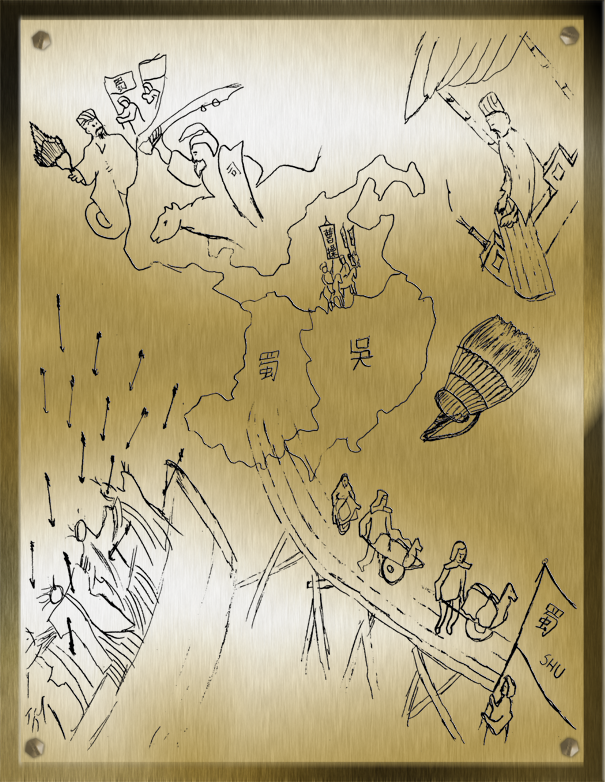| Time Period | The Three Kingdoms Period (220-280) |
| Geographical Region | The realm of the three kingdoms (Wei, Shu, Wu) |
| List of Symbols |
|
The present plaque is consisted of two parts. The first is a map of the three kingdoms and the second an outline of the Shu kingdom’s developments, which is in accordance with that of Zhuge Liang’s personal career. Overall this plaque aims to capture the world order and a sensation of the Three Kingdoms Period from Zhuge Liang the storyteller’s point of view.
Zhuge Liang, as the chancellor of Shu, lived a life in constant warfare against Wei and Wu. For this reason a map of the three states is a symbol most necessary to honestly represent the life of Zhuge and the time of chaos that he was in.
Throughout the Chinese history, Zhuge was widely acclaimed for his intelligence and military prowess. To fully understand his accomplishments, one must first understand his starting point and the resources that he had at hand—thus is the necessity of comparing the numbers of each state’s forces, as represented by the helmets on the map. Shu’s armies were merely one eighth as many as that of Wei. However, during Zhuge’s time as a minister, Wei never managed to have the deciding military advantage over Shu.
In short, the map on the left is designed to give a glimpse into Zhuge Liang’s world and his own place in it. It was a world where three Chinese states had equal political status and were constantly at war with each other; Zhuge Liang was an important figure from a state whose forces were inferior in number, who, however, had his entire promising career just in front of him.
On the right of the plaque are showed three representative career events in his life. The first scene depicts the three visits from Liu Bei, the future warlord of Shu, which was the beginning of Zhuge’s minister career. The second scene is the famous “arrows-borrowing with thatched boats,” a memorable episode from the Battle of Red Cliffs. The Battle marked a climax of Zhuge’s career. The third scene is the death of Liu Bei, which, though neither the beginning nor the ending of Shu’s decline, foreshadowed Zhuge Liang’s lost cause.
The drawing at the top-right corner is Liu Bei’s three visits, in which Liu raised his folded fists to Zhuge as a gesture of respect, while Zhuge had a buoyant air indicating that he was someone sought after. At this point Zhuge was a hermit and Liu Bei, hearing about his talents, had to visit him thrice to finally meet him in person. In their meeting he gave Liu a strategic plan on how to conquer the entire China, which was also the start of his interference with the world order.
The drawing in the middle is the borrowing of the arrows. Zhuge Liang was sitting in a boat at perfect ease while the Wei (the state on top of the map) arrows kept shooting to the straws on his boat. This is a story about Zhuge, facing the shortage of arrows, coming up with a clever solution. The contrast between the shooting arrows and his composure suggests his capability as a strategist. More importantly, however, this scene represents a larger picture of the Red Cliffs Battle. During the Battle, Shu, allied with an equally weak Wu, won a decisive victory over the formidable Wei, which also settled a new balance of power among the three kingdoms. This scene was thus a climax of both Zhuge’s personal career and that of Shu.
The drawing at the bottom-right corner is Liu Bei in his deathbed, his right hand on Zhuge Liang’s, entrusting Zhuge with his kingdom and his heir. By this time Liu Bei had lost his two great generals and dear friends; Shu had lost Jingzhou, a place of critical strategic importance, and was nothing like what it was before. Ever since then Zhuge had been struggling to keep his promise with Liu Bei, serving the incompetent new king, waging conquest on the North for five times. Shu was never lost during Zhuge’s lifetime, but it didn’t seem to have a very optimistic future either. The death of Liu Bei was certainly a sign of the faltering Shu power.
These three drawings together create the outline—the rise of fall of Zhuge Liang and the Shu kingdom. The two halves of the plaque combined provide an insight into the world order during the Three Kingdoms Period, with a focus on Shu’s side of story, as represented by Zhuge Liang’s personal fate. The Three Kingdoms Period is remembered in this way—not by its cultural achievements or economic developments, but by the three kingdoms’ relationship with one another and the numerous historical events and romances that happened during wartime.
James Potter is a sophomore at the time of this project, an English and East Asian Studies major at the University of Rochester. .


